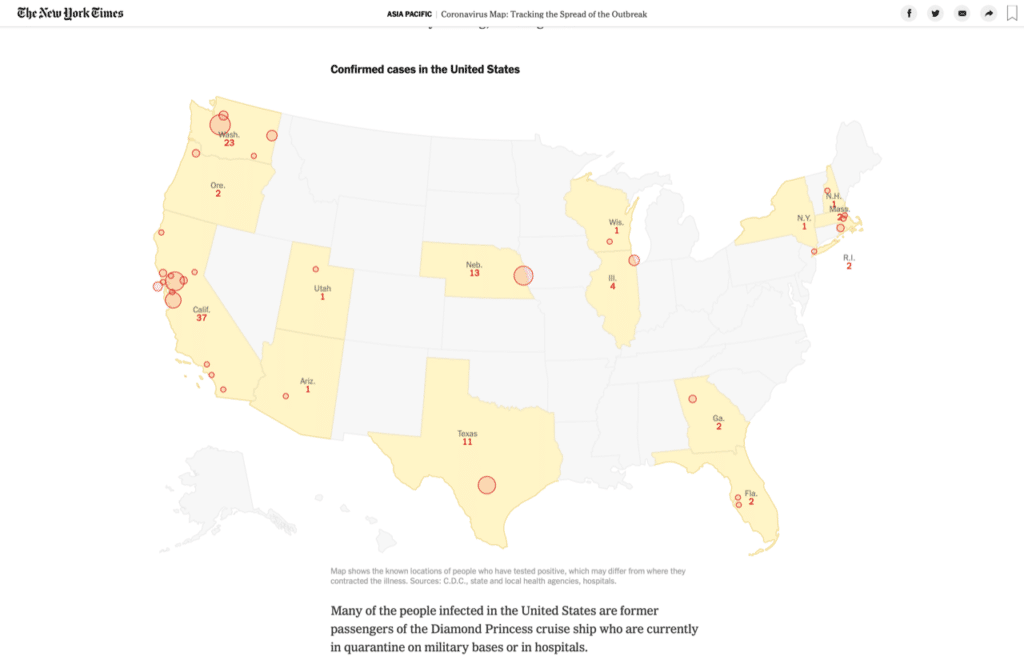We want to provide this update on the current COVID19 situation, both within our company, and across the nation.
As always, we recommend the CDC website for the most accurate, updated information at https://www.cdc.gov/coronavirus/2019-ncov/index.html. We would also recommend reading the very informative full transcript from the CDC COVID19 Telebriefing on Tuesday March 3, which provides an update on CDC priorities as well as an excellent Question & Answer section with reporters from major news organizations. https://www.cdc.gov/media/releases/2020/t0303-COVID-19-update.html
2 cases from Atlanta, GA and 1 case from Raleigh, NC have been reported within the last 1-2 days. No other QDP markets have confirmed cases, but there is a high likelihood of further widespread transmission so we are monitoring the situation closely. Note that the CDC updates its national database at noon daily, so news reports in a certain location may preempt the appearance of the case on CDC website (e.g. North Carolina case on Tuesday had not yet appeared on CDC or NYTimes map)
Facts about COVID19:
- Shedding of virus occurs prior, during and after symptom onset. Specifics are still being determined.
- Incubation period 5-12 days, thus recommendation for 14 day isolation/quarantine following symptom resolution.
- Doubling time for community spread is 7 days, so epidemic transition to pandemic is likely, unless personal and community efforts are carried out effectively (see below)
- Average of 2.2 people are infected by each patient with COVID19
- Case fatality rate is 2-4% among Chinese, but likely 1-2 % in United States. Influenza mortality is approximately 0.1% (1 death per thousand cases) but given the millions of infections, the death toll from flu is tens of thousands annually.
- Fatality and serious complications occur more commonly in older patients, males, smokers, underlying lung or immune conditions; infants and children typically run a milder course, possibly due to maternal antibodies.
- CDC anticipates 12-18 months for a vaccine and effectiveness unknown. Typical influenza vaccines are roughly 50% effective and still highly recommended.
- Treatments, such as antiviral medications, are currently in clinical trials and CDC anticipates some options much sooner than a vaccine becomes available. In the meantime, supportive care is the mainstay of treatment. Mild cases can recuperate at home like common colds.
- CDC announced today that diagnostic testing kits have been distributed to all states and availability for testing of the US population is approaching 100%, although results may not be immediate.
The absolutely best course of action remains common sense strategies for identifying potential infections and reducing transmission of all viral infections like influenza or COVID19:
- Stay home when sick – QDP is proactively prioritizing efforts to establish remote work options for employees who can effectively function at home during or following an illness or recovery and/or caring for family member(s). Most illnesses will be mild but patients will need to remain away from contacts for 2 weeks following resolution of symptoms (fever/chills, cough, shortness of breath, aches, nausea or cold-flu-like symptoms)
- Wash hands frequently with soap and water for 20-30 seconds or use hand sanitizer gel (effective but less than soap/water), particularly after coughing or sneezing. Avoid rubbing nose/mouth/eyes. This remains readily available at all practice sites.
- Clinical staff should don OSHA appropriate PPE (personal protective equipment) based upon Universal Precaution protocols. N95 masks are not recommended unless caring for a high risk PUI (person under investigation). These patients should also wear a mask and need isolation in a separate exam room, preferably those with an exhaust fan. Clinical caregivers should also wear a mask, gown, eye protection, and gloves while preparing the patient for transport to home, urgent care, PCP or hospital, depending on condition.
- ‘Social Distancing’ remains an important strategy in public health to reduce community transmission. One should consider limiting or avoiding public venues with cramped conditions, e.g. sporting events, music concerts, public transportation. Close contact is defined as 6 feet, so avoiding close contact with anyone exhibiting cold or flu-like symptoms should help reduce new cases.
- Spread occurs from person to person primarily from respiratory or oral droplets e.g. coughing or sneezing. Transmission can also occur, however, from direct contact with surfaces exposed to these droplets. The duration of infectivity is unknown. Therefore, we recommend cleaning work stations regularly/daily and especially after coughing or sneezing nearby.
QDP is focusing intensely on our supply chain to avoid disruptions in medical supplies like antibiotics, and for protective gear like face masks, which are predicted to potentially become in short supply. Please know that we have already employed numerous strategies to address this issue and are working diligently, as are all other health care institutions. Many of these are higher priority centers (urgent care, PCPs, hospitals) but we are doing everything in our power to ensure our clinics remain safe, viable and functional.
QDP has developed the attached signage for placement at all facility entrances to reduce exposure of receptionists, front desk staff, other patients, and our own personnel. We will also provide face masks and hand sanitizer for anyone experiencing flu symptoms who presents to the office and ask them to reschedule their non-urgent dermatology appointments. Patient reminder calls/texts also recommend staying home if sick.
Thank you and stay well,
John Albertini, M.D. | CMO
Alan Wenk | COO
Bill Southwick | CEO
